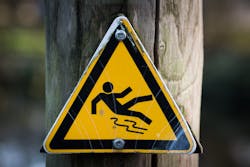Safety Spotlight: Preventing Slips, Trips, and Falls
Whether you’re in the field or heading home for the evening, slips, trips, and falls pose a hazard to those of all ages. The amount of risk associated with the mileage we put on boots is second only to the exposure we face behind the wheel while driving. While we have little to no control over our reflex actions when we fall, it’s important to be aware of the potential injuries, to understand how to fall and how to avoid falling.
Preventing slips, trips, and falls can be as simple as reciting the children’s song, “Head, Shoulders, Knees, and Toes.” Let’s start at the top.
Head
According to the Centers for Disease Control and Prevention (CDC), one out of five falls causes a serious injury such as broken bones or a head injury.
When traveling by foot, take the time to scan your surroundings for hazards, focus on the immediate terrain, and be conscious of potential risks in your path. Use the Active Safe Walking method – an awareness where you focus on every step you take. Hyper-focusing on our primary objectives can lead to missing potential hazards that are directly underfoot.
Shoulders
Equally important is knowing how to fall in the event you do. When you fall, avoid the dangerous FOOSH — “fall on outstretched hand,” which often results in a broken wrist or elbow; or lacerations from contacting an object. A FOOSH injury may also jam your arm bone up into your shoulder, causing a proximal humeral fracture.
Our first instinct is our attempt to stop the fall, therefore, we hold our arms out. Harvard Medical School offers a handful of tips on how to fall without injury:
- Lean forward into the fall—this gives you some control over direction.
- Fall sideways, if possible.
- Aim toward open areas and grass or dirt rather than concrete.
- Aim away from other people and away from objects that can cause puncture wounds or fractures.
- Swing your arms sideways to direct your fall.
- Twist your shoulder to protect your head.
- Keep your knees bent and your feet down.
- Fall like a sack of beans—relax everything.
- Fall on the soft, fleshy places, like your butt and thighs. These areas have more protection and are lower to the ground.
- As you complete the fall, try to roll to your side in a ball. This will spread the impact to reduce injury and stop you from rolling further.
Knees
Smooth surfaces typically have the conditions for slips. Uneven terrain can be dangerous due to areas having severe slopes, holes, tree roots, or rocks in your path. These types of terrain can be found everywhere, and we experience a similar number of incidents of slips, trips, and falls in residential areas compared to rugged and forested environments. Watching where you walk is key. This sounds overly simplistic but those who are cautious about their foot placement will likely avoid ankle and knee injuries.
Tips for traveling on uneven terrain:
- When walking downhill/downslope, walk perpendicular to the hill, taking shorter strides and going slowly while remaining cautious of obstacles.
- Watch for the “step and fall.” This occurs when the front foot lands on a surface lower than expected, like stepping into a hole or when stepping onto an object, turning the ankle.
- Hiking sticks can also help provide stability on hills, relieve stress on the back, knees, and legs, help move aside brush and branches, and help test unknown ground before walking.
Toes
Protect your feet with the proper footwear. A boot tread must be rugged/aggressive for no-slip traction on loose terrain. Boots must also be a minimum of 6 in. tall for appropriate ankle support. If icy conditions exist, use boot cleats, chains or traction-enhancing shoe gear.
A Safer 2021
The National Safety Council (NSC) and the Occupational Safety and Health Administration (OSHA) announced the Top 10 most frequently cited workplace safety violations for 2019 and two of those violations are related to slips, trips, and falls-related. While the 2020 list has not been released yet, let’s strive to wipe slips, trips, and falls from the 2021 Top 10 list by taking the proper precautions.
For the arborists and climbers out there, an additional resource for safety information includes an infographic provided by ACRT.
Take the 3-point contact rule, highlighted in the infographic, for example. By always having three limbs in contact with the area you are climbing and only having one limb in motion at any time, you are actively preventing falls outdoors.
Work safer and have a great 2021!
About the Author
Keith Pancake
Keith Pancake is a safety manager serving ACRT and Bermex. He has been involved in the UVM industry for over 10 years. He is an ISA Certified Arborist and Utility Specialist, an NSC certified Defensive Driving Instructor, and the 2018 Utility Arborist Association’s Silver Shield recipient.
